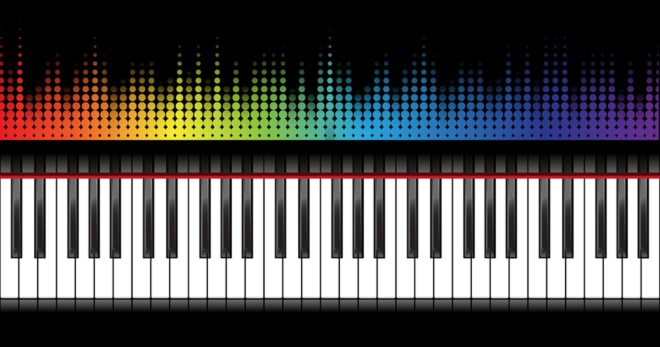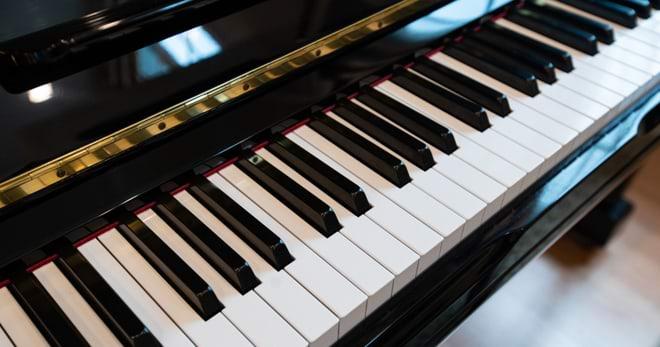If focus and purpose are missing from your practice time at the piano, try these innovative strategies while you learn how to play piano.
The great thing about piano playing is that time just seems to evaporate. We soon lose ourselves in what we are doing, and when things are going really well, we can shut out the world for hours at a time.
The flip-side to this is that we can easily end up achieving little as we amble from one random section of a piece to the next, enjoying ourselves but not actually improving what we are doing.
There is clearly a distinction to be drawn between playing and practising – but also between practising and practicing.
Only once we can do something well are we in a position to say we can practise it like dentists operate a ‘practice’, or Buddhists practise their faith. Until we reach that point, we would be best advised to adopt a more focused, nitty-gritty approach to the various elements of our playing, one by one.
This is where practising happens. Every piano teacher warns against routinely playing through a piece a dozen times without some sort of goal in mind, but surely there is more to using our practice time wisely than this?
Pianoforall Course – Ingenious Way to Learn Piano & Keyboard
The Ten-by-Five Method
If finding an hour for practice is a challenge, or even half an hour, try this ‘Ten-by-Five’ method. I’ve enjoyed great success with adult learners (beginners and even quite advanced recitalists) by this method.
It’s all about frequency and focus, and is an adaptation of the ‘ten times’ rule, whereby we repeat something ten times in order to ingrain it once and for all (having first made sure that what we are repeating is accurate, of course!).
Importantly, each practice session lasts just five minutes. If you work or study from home, you may find yourself walking past your piano 50 times a day.
Every now and again, stop, sit down, and really concentrate on a bar or two of something, carefully and methodically for just 300 seconds.
Then move away from the instrument, get on with something else and come back to it a little while later for another mini-session.
You could think of each visit to the instrument as ‘power practice’.
Mistakes
Making mistakes is an inevitable part of piano playing; and by this I mean performing, as well as practising. But you can turn your mistakes into positive experiences, and prevent them from becoming disproportionately annoying or frustrating.
Teachers point out our mistakes all the time (perhaps a little too often), but how well are you able to spot your own mistakes when at home, alone?
It goes without saying that mistakes are in the ear of the beholder.
A top performer’s definition of a mistake might be a minuscule blur here, or a less persuasive expressive detail there, whereas most amateurs think of mistakes as blunders on a kind of sliding scale:
Wrong notes, imprecise rhythms, memory slips, ragged pulse, poor coordination, overlooked dynamics, a missed ritardando, and so on.
The level your playing has currently reached will partly define the kinds of mistakes you’re most likely to make.
If we wait until all mistakes have been airbrushed out of our playing, we will never have earned the right to say we are playing well!
Come to an understanding with your mistakes. Learn from them, smile at them, accept them (for now at least) and resolve to iron them out patiently.
A perfect performance is like the perfect round of golf – it can never exist – so consider each mistake a gentle reminder of what deserves extra attention.
1) Reserve full run-throughs for when a performance event is on the horizon, and occasionally for a welcome sense of release.
2) Try the ‘Ten-by-Five’ method, not only on the days when you’re hard-pressed to find time for a longer practice session.
3) Experiment with slow practice and hands-separate work; usually, start at the end and work backwards.
4) If you feel it helps, keep a practice notebook to hand, or try mind-maps. Stay open to chance discoveries, too; they are often the most eye-opening and rewarding.
5) Try not to resent your mistakes. Without mistakes we’d be perfect, and perfect pianists are deprived of the joy of having something still to aim for.
Slow Practice versus up-to-speed Practice
The debate among players and teachers concerning the merits of slow practice will doubtless rage on.
I’ve met many pianists who cannot abide any form of slow work (they’re usually brilliant sight-readers but not good improvers), especially with a metronome clicking away unyieldingly, and others who are convinced that it’s the only way to crystallise the trickier technical elements of a piece.
The truth possibly lies between these extremes. Practising something at a very slow pace can be like shining a spotlight on the problem, or holding a magnifying-glass up to it. Slow practice shows up fractional unevenness in rhythm or touch, and even glaring errors such as missed accidentals.
However, such work can also be counterproductive, and limited in its use. Our choice of fingerings cannot be properly put to the test, and the rhythmical aspects of a piece cannot leap to life.
Even so, slow practice often helps with unpicking knottier passages and is a good strategy to return to periodically, even when you think you’ve moved your performance up to the next level.
Hands Separate Practice versus Hands Together
It is true that each hand needs to be taught its individual parts separately (and with comfortable and effective fingering), at least in more complex music such as counterpoint or technically challenging new music.
However, many players – and especially adults – find that no matter how much separate hand work they do, they simply cannot unite the two at a later stage.
You could try Margaret Fingerhut’s nifty trick, which she learned from her teacher, Cyril Smith. Play one hand out loud, while the other taps out its notes on the piano desk (or perhaps on your knee).
This allows you to hear precisely what the ‘playing’ hand is up to, while at the same time practising the all-important business of assembly.
Back to Front
The hardest part of a piano piece is very rarely to be found at its beginning!
Usually, as a composer builds up the intensity or drama, the technical challenges will mount: ever-richer harmonies, wide-spaced chords and thicker textures, more complex chromatic passages and so on.
Thus we should start learning and practising at the end of most pieces, and then work our way progressively towards its beginning. If we do this, we are likely to encounter the big challenges and climax points much earlier in the learning process.
Working this way can also help with memorizing: if we learn each section from the back to the front, our natural instinct will always be to jump forwards, not backwards, when things go wrong.
Be Spontaneous, but Have a Firm Plan!
Don’t worry if this sounds like a contradiction in terms. During practice, things will sometimes happen beyond our immediate control, such as the sudden onset of tiredness or wrist ache.
Just like the good school-teacher, who suddenly deviates from a topic to tell the class something far more interesting, we need to be alive to the here and now.
For example, we might trip over a new fingering quite by accident, which works brilliantly – we should immediately stop what we are doing, hunt around in the same piece for similar places where our eureka fingering will work equally well, and glue it firmly into place, in our minds and under our fingers, before we forget it.
Some of us use a practice book to write down details of what we’ve practised, for how long, and perhaps the particular challenges we have met and faced.
Such a strategy helps us to stay on the straight and narrow. Others may find that mind-maps are useful.
It pays to be organized and to stick to one single objective at a time. Don’t become too much of a slave to the clock, but aim to concentrate hard for the bulk of each practice session and then let yourself of the leash every now and then.
Full run-throughs
There are times when playing through whole pieces in one fell swoop is precisely what is needed. I’m thinking principally of those on the cusp of giving a recital, taking an exam or performing in some other way.
Stamina can only come from ‘doing’, and full run-throughs are the only way to test that every note and nuance is safely stored away.
The danger is that we pre-empt this point and convince ourselves we are ready to blast away, when in fact there are niggling problems and ragged areas still to tidy up. Honesty is an essential quality of private practice.
There is little point in devoting time to sections that you can already play well. If we think of a practice session as a self-taught lesson, then we immediately see why we have to take a more responsive (and responsible) approach.
This does not mean we cannot occasionally allow ourselves the simple pleasure of whizzing through a piece that’s not yet completely mastered.
We are humans, not robots, and I personally allow myself a good week or two of heroically charging at a difficult new piece in order to reveal to myself that a) this is going to be a good piece for me to really get to grips with, and b) where the really tricky areas of it are lying in wait.
Practise Away from the Piano
The good thing about practising away from the instrument is that we can instantly expand the amount of piano-centred time available to us.
You might only have 20 minutes (or four times five minutes!) to devote to practising each day, but if you then need to spend an hour sitting on a train, you can use this to do some invaluable score study or thoughtful penciling-in of details, harmonies, fingerings, page-turns and structural aspects that might never have occurred to you when sat at the piano.
Piano practice should always be a challenge, but also a joy – we need to feel we are steadily growing and advancing; however brief each session needs to be. Then we won’t feel we are spending time, but investing it wisely and purposefully.
 Expert eBooks Courses | Online-eBook-Download.com Latest digital books and courses, Tips & Tricks, How-to guides, free ebooks, software discounts, coupons & much MORE… Instant Download
Expert eBooks Courses | Online-eBook-Download.com Latest digital books and courses, Tips & Tricks, How-to guides, free ebooks, software discounts, coupons & much MORE… Instant Download



